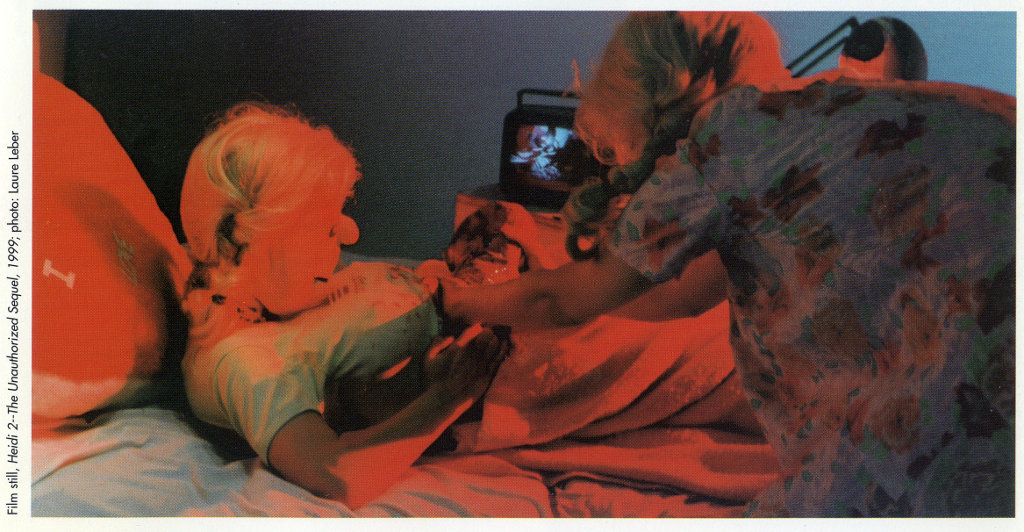Tom Moody
VERY Magazine, Fall, 1999, pp. 16-17
[link] [link]
In their 1992 video Heidi, artists Paul McCarthy and Mike Kelley turned the classic tale of a young girl’s coming of age into a three-ring circus of family dysfunction. In this orgy of obsessive-compulsive behavior interspersed with lofty Socratic dialogues on the relationship of nature and culture, Grandpa, a sadistic paternal figure, teaches Heidi and her brother Peter what they need to know to grow and thrive in the adult world: how to read, how to get beaten up, how to push sausages out of your ass. Now New York-based artists Laura Parnes and Sue de Beer have given the story a media-saturated spin in a two-channel video installation titled Heidi 2. As the script notes, the new production "is not a critique or on homage but a sequel, and follows the roles of any good sequel: more blood, additional celebrities, and more special effects."
The video begins with a disgusting birth scene suggesting a cross between Cindy Sherman’s sex toy photos and the monster births in Larry Cohen’s "It’s Alive" films. The character of Heidi later appears as both mother and daughter, played by the two artists in rubber Charlie Brown and Pigpen masks, Grandpa is reduced to a bit player and Leonardo de Caprio (an actor in a cardboard mask) fulfills the celebrity quota. Mocking parenting in the age of rampant bulimia and art school instruction in the age of Abjection 101, Heidi 1 shows Heidi 2 how to projectile vomit (“Like this?” daughter asks -- big splash -- ”No, that’s too self-conscious,” mom replies) and at the climax of the tape, how to “self-operate.” In this disturbingly affectless scene, combining radical weight-reduction surgery with Teletubbies-style auto-surveillance, Heidi 2’s stomach is cut out, tossed into a bucket, and replaced with a TV monitor carrying her image in a continuous live feed.
To those familiar with the artists' work, Heidi 2 is an intriguing marriage of sensibilities. Parnes’ video No Is Yes, 1998, limns a more straightforward (but equally depraved) narrative in which two teenage girls murder a misogynist punk rocker in a Thelma and Louise-style face-off, give him a Clueless-style makeover (stripping him nude, tying him up, adorning him with knife-inflicted scratch-iti), and then ask their mentor, a dominatrix named Sarah, for Pulp Fiction-style help in disposing of the body. (“Who do you think I am, Harvey Keitel?” Sarah asks). Enlivened by quick editing and MTV-style inserts, No ls Yes is a teen rebellion film reinterpreted for a gallery context and its bleak message -- that rebellion in a world of commodified nihilism is meaningless -- echoes throughout Heidi 2.
De Beer, in her own solo work, has a flair for catchy, surrealistic images, resembling the shock iconography of fashion and advertising (e.g. Diesel’s recent “dead teenagers” campaign) but with a creepy, personal vibe. Through low-budget f/x, including digitally altered videos and C-prints, she has depicted herself as a pair of clones in a languid make-out session, an ax-murder victim split from skull to sternum, and an impossibly long-legged Frankenwaif straining to touch the floor with her fingertips. Although arrived at collaboratively with Pames, Heidi 2’s vomiting scene -- with its doppelganger composition and obvious Exorcist reference -- recalls de Beer’s characteristic union of horror-movie scenes and choreographed body art pathologies.
This immersion in media and popular culture sets Parnes and de Beer apart from an older generation of performance artists (McCarthy, Schneeman, Nitsch), who seek to heal a split between a “repressed, cultural” self and an “authentic, natural” self through ritualistic acts of transgression (fecal smearing, orgiastic sex, and so on). In de Beer’s and Parnes’ view, no split exists because everything is mediated: the most extreme acts can be found on tape at the corner video store and “real” experience is suspect. Rejecting the superior vantage point of the artist/shaman, the artists use pop culture tropes without apology, expressing the most “primal” events -- childbirth, orgasm, incestuous rape -- in the idiom of sitcoms, video games, and splatter films.

